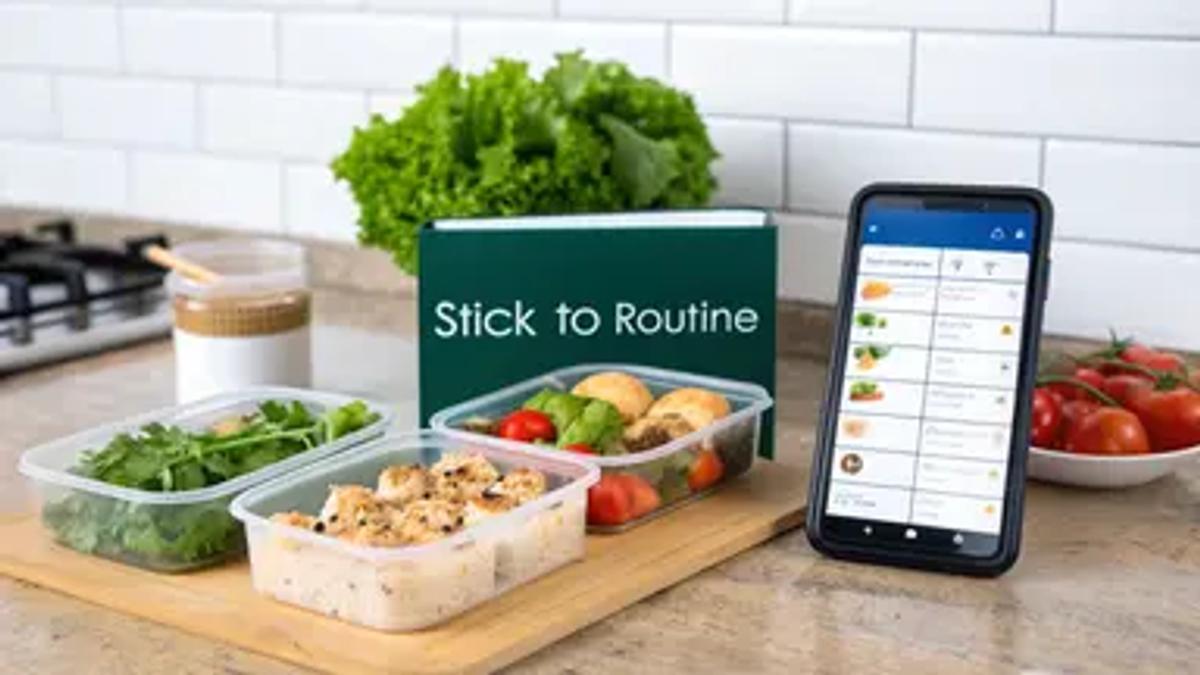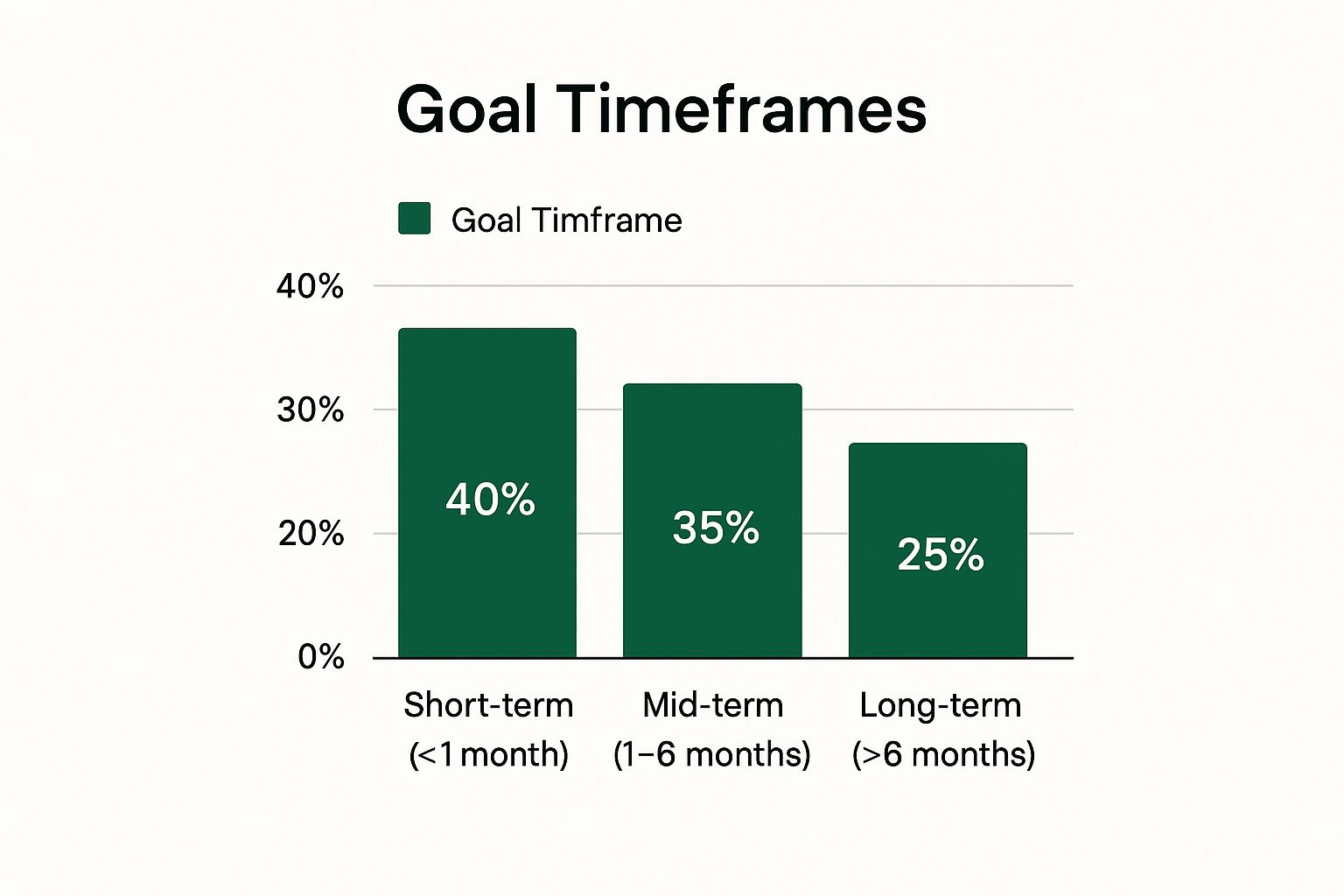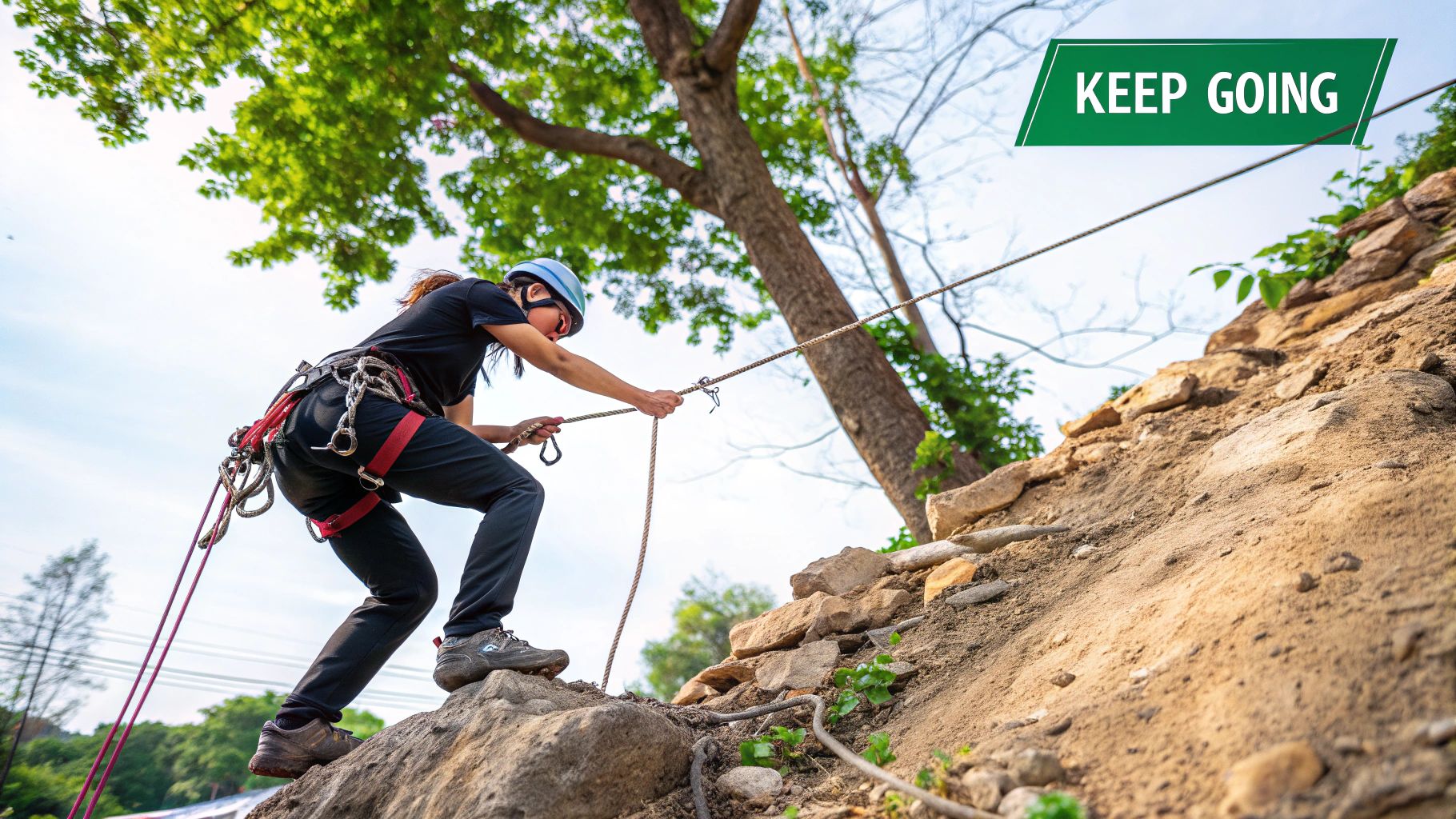How to Stick to a Routine Without Giving Up
Tired of failed attempts? Learn how to stick to a routine that actually lasts. Our guide uses proven behavioral science to help you build habits for good.
Ready to Simplify Your Meal Planning?
Get personalized meal plans and grocery lists automatically matched to your macro targets.

How to Stick to a Routine Without Giving Up
Ever feel like you're stuck in a hamster wheel, constantly starting a new routine only to watch it crumble a week later? You’re not just "bad at it," I promise. There are some very real, very human psychological forces at play here.
The secret to actually sticking with a routine isn't about having superhuman willpower. It's about getting smart and outmaneuvering the invisible saboteurs that love to trip you up.
Why Your Routines Keep Ghosting You
Let’s be real for a second. How many times have you blamed yourself for not being disciplined enough? You scroll through social media, see someone with a flawless morning routine, and immediately think, "What is wrong with me?"
Nothing. Absolutely nothing is wrong with you. Your brain is just hardwired to resist big, sudden, demanding changes.
Think of willpower as a phone battery. If you rely on it to force your way through a brand-new, ambitious routine, you’re going to hit zero percent before you know it. Lasting consistency isn’t about brute force; it's about designing a system that works with your human nature, not against it.
The All-or-Nothing Perfectionist Trap
One of the biggest culprits is what I call the all-or-nothing mindset. You map out this picture-perfect plan: wake up at 5 AM, meditate, journal, hit the gym, and chug a green smoothie, all before the sun is properly up. It might even work for a couple of days.
But then, on day three, you oversleep.
Instead of just shrugging it off, your brain screams, "FAILURE!" You think, "Well, I already messed up, so I might as well scrap the whole day and start over on Monday." This perfectionist trap turns a tiny stumble into a full-blown face-plant, making it impossible to build any real momentum.
The goal isn't a perfect streak; it's progress. One missed workout doesn't magically erase the ten you already did. The real skill is learning to bounce back fast from a small hiccup without letting it spiral.
The Hidden Forces Working Against You
Your environment and the people around you have a massive influence, too. You might be fired up to stick with that new meal plan you got from Meal Flow AI, but then a coworker waltzes into the office with a box of donuts. Suddenly, your best intentions are in a cage match with a powerful, delicious-smelling cue right under your nose.
This isn't a personal failing; it's a universal human challenge. Sticking to a prescribed plan is so tough that it's a huge problem even in high-stakes medical situations. Data from World Adherence Day 2025 revealed that in high-income countries, the average adherence rate to medical treatments is only about 50%. If half of all patients struggle to follow doctor's orders, it just goes to show how hard it is for anyone to follow a strict regimen. You can read more about these global adherence challenges on Serviermedicalhub.com.
When Your Routine Fights Your Reality
Finally, a lot of routines fail simply because they aren't built for your real life. That aspirational schedule you copied from an influencer doesn't factor in your kid waking up sick, a surprise project from your boss, or just one of those days where you feel completely drained.
When your plan has zero flexibility, it’s brittle. The first gust of chaos shatters it into a million pieces. Learning how to stick to a routine is really about creating a plan that can bend without breaking—one that can adapt to the beautiful, messy reality of your life.
Crafting a Routine You Can Actually Follow

Let’s be real for a second. Grand, life-altering resolutions almost never stick. The routines that actually last aren't born from a single burst of manic motivation; they're built brick by brick, with tiny, almost laughably small actions. If you want to know how to stick to a routine, the secret is to ditch the "go big or go home" pressure. You need a system that feels less like a chore and more like a natural part of your day.
The first step? Stop using shame as your fuel. If you're building a new habit because you feel like you should—like you aren't good enough right now—that routine is already standing on shaky ground. Instead, get curious. Treat it like a fun experiment where the only goal is to see what feels good and what works for you.
Find Your Keystone Habit
Think of a keystone habit as the first domino to fall. It’s that one small, simple change that surprisingly kicks off a whole chain reaction of other good behaviors. It’s not about the habit itself, but the ripple effect it has.
For some people, it's as simple as drinking a glass of water right after waking up. For others, it's laying out their workout clothes the night before. Making your bed doesn't just give you a tidy room; it's a tiny "win" that proves to yourself you can be disciplined. That little victory might just be the nudge you need to tackle that quick meal prep you planned with Meal Flow AI.
So, what could your keystone habit be? Think of one tiny action that would make the rest of your ideal routine feel just a little bit easier.
Start So Small It's Impossible to Fail
This is where most people go wrong. We design routines for our best selves on our best days. Don't do that. Instead, design a routine for your worst self on your most tired, can't-be-bothered day. That's how you build unstoppable momentum.
For instance, instead of vowing to work out for 30 minutes every day, make the goal to simply put on your running shoes and walk to the end of your driveway. That's it. Anyone can do that, even when motivation is at an all-time low.
The real magic happens when you lower the barrier to entry so much that skipping the habit feels more difficult than actually doing it. A "two-minute rule" can be a game-changer: scale down any new habit until it takes less than two minutes to complete.
Use Habit Stacking to Your Advantage
One of the slickest tricks for making a new habit stick is to piggyback it onto an existing one. It's called habit stacking. Your brain is already wired for your current behaviors, so you're just adding one little extra step to a well-worn path.
Here’s how it looks in the real world:
- After I pour my morning coffee, I will open my journal and write one sentence.
- After I put my dinner plate in the dishwasher, I will wipe down the kitchen counters.
- After I brush my teeth at night, I will stretch for five minutes.
This simple formula—"After [current habit], I will [new habit]"—takes all the guesswork out of it. You no longer have to decide when or where to do your new thing. It’s already locked in.
By focusing on these small, connected steps, you stop white-knuckling your way through the day and start creating an effortless flow. Before you know it, you're sticking to a routine for good.
Tailoring Your Routine to Your Real Life
Let’s be honest: there’s no such thing as a one-size-fits-all routine. You aren't a one-size-fits-all person, so why would your daily plan be? That "perfect" routine you saw on Instagram? It could be a total disaster for your actual life.
The real secret to making a routine stick isn't about copying someone else. It's about designing a flexible plan that actually works with the life you have right now. Your energy, your mood, even your bank account—they all have a say in whether you'll stay consistent.
For instance, a hardcore morning workout sounds amazing in theory. But if you're wrestling with anxiety, it might just be a recipe for a full-blown panic attack. The goal is to build a plan that works for you, not against you.
Perform a Personal Routine Audit
Alright, time for some real talk. Take an honest look at your life as it is today. Not your fantasy life, but the messy, beautiful, real one you're living. A quick "routine audit" helps you pinpoint your personal roadblocks and secret strengths, making your plan tough enough to handle whatever life throws at it.
Grab a notebook and ask yourself a few questions:
- Energy Levels: Are you a morning person or do you come alive after sunset? Don't force a 5 AM wake-up call if your best ideas and biggest energy bursts happen after dinner.
- Mental Health: On days you're feeling anxious or just plain blah, what activities feel supportive? What feels like too much? Maybe a quiet walk in the park is a better bet than a loud, crowded gym.
- Financial Situation: If money's tight, a routine that depends on a pricey gym membership or fancy organic ingredients is setting you up for failure. What are the free or low-cost alternatives that still feel good?
This isn't about judging yourself. Think of it as gathering intel to build a smarter, more personalized system that truly supports you.
Make Your Routine Resilient
A rigid routine shatters the second things go sideways. A resilient one just bends.
My favorite trick? I call it the "High-Battery vs. Low-Battery" plan. On "high-battery" days, I tackle my full, ambitious routine. But on "low-battery" days—when I'm tired, stressed, or just not feeling it—I have a simplified, bare-minimum version ready to go. This way, I never break the chain completely.
This isn't just a hunch; behavioral science backs this up. Sticking to a routine isn't purely about willpower. It's deeply connected to our unique life circumstances. In fact, research shows that things like our age, income, and mental health have a huge impact on our ability to stay on track. If you're a science nerd like me, you can dive deeper into the psychological factors in routine adherence on PMC.
This focus on real-world factors is why personalization is so critical. Here’s a quick look at how different life situations can affect your routine and how you can adapt.
Personalizing Your Routine Based on Lifestyle Factors
This table breaks down common challenges tied to different life factors and offers simple, personalized strategies to help you stay consistent.
| Influencing Factor | Common Challenge | Personalized Strategy |
| Parenting | Unpredictable schedules and constant interruptions. | Create "micro-routines" (e.g., 10-minute cleanup) and have a "Plan B" for chaotic days. |
| High-Stress Job | Mental and physical exhaustion after work. | Schedule restorative activities (like a walk or meditation) immediately after work to decompress before other tasks. |
| Living with a Chronic Illness | Fluctuating energy and physical limitations. | Adopt a "low-battery" version of your routine for flare-up days, focusing on rest and minimal essential tasks. |
| Freelancing / Irregular Income | Financial uncertainty and lack of a fixed schedule. | Build routines around free activities (e.g., home workouts, library visits) and use time-blocking to create structure. |
By acknowledging these factors instead of fighting them, you give yourself a much better shot at success. It's about being realistic, not perfect.

As you can see, people are often focused on the short game. That’s why a flexible, adaptable routine is your secret weapon. It helps you nail those immediate wins without burning yourself out on the way to your bigger goals.
Let Smart Tech Be Your Accountability Buddy

Let's be honest—your phone is probably already glued to your hand. So why not make it work for you instead of against you? Forget basic alarms. It's time to turn your digital sidekick into a powerful ally for building habits that actually last.
Think of it as having a tiny, digital coach in your pocket. This coach never gets tired of reminding you what’s next, cheering you on, or showing you just how far you've come. It’s the perfect nudge for those moments when your willpower decides to take a coffee break.
Turn Your Routine Into a Game
One of the sneakiest—and most fun—ways to use tech is to gamify your progress. Apps that dangle streaks, points, and digital rewards in front of you can give you that little dopamine hit that turns a chore into a challenge you actually want to win.
For instance, some apps let you grow a virtual plant every time you check off a task. It sounds a bit silly, I know, but you’d be surprised how motivating it is to watch that little digital tree thrive because of your efforts!
Another classic trick is tracking your "streaks"—how many days in a row you’ve stuck with your plan. Seeing that number climb becomes its own reward. You’ll find yourself thinking, "I've come this far; I'm not about to break the chain now!"
Put Your Accountability on Autopilot
Technology can be the ultimate accountability partner because it automates the nagging for you. It’s no longer just about you remembering to do the thing; your phone can handle the heavy lifting of reminding and tracking your wins.
The real magic here is creating external cues and reinforcement. It's like getting a text from a friend asking, "Hey, did you plan your meals yet?" but without any of the potential awkwardness.
This isn't just a clever life hack; it's a fundamental shift in how we manage our well-being. A 2024 Deloitte survey of healthcare leaders revealed that 72% see digital tools as a top priority for improving consumer engagement. They know that apps and trackers can simplify complex routines and give people the timely prompts they need to stay on track. You can dive deeper into their findings in the 2025 global healthcare executive outlook.
Become a Data Detective for Your Own Life
Beyond simple reminders, smart tech lets you uncover hidden patterns you'd never spot on your own. By looking at your data, you can become a detective in your own life.
- Sleep Trackers: Ever notice you’re way more productive after getting a solid seven hours of sleep? Seeing the data proves it’s not just a feeling.
- Fitness Apps: Watching your running pace improve week after week gives you concrete proof that your hard work is actually paying off.
- Meal Planners: This is where tools like Meal Flow AI shine. They don't just solve the "what's for dinner?" crisis; they help you see trends in what you're eating, making it so much easier to stick to your health goals.
By using tech this way, you’re not just trying to remember your routine. You’re building an entire support system around it.
How to Bounce Back When You Fall Off Track
Look, falling off the meal-planning wagon isn't just possible; it's practically guaranteed. It's not a failure. It's life. The real magic isn't in maintaining a perfect, unbroken streak. That's a myth. The secret is getting really good at the comeback.
Let’s be honest. Life gets messy. The kids bring home the plague from daycare, your boss drops a surprise project in your lap, or maybe you just wake up and feel completely out of gas. A super-rigid plan will crack under that kind of real-world pressure. So, here’s your playbook for when things go sideways—how to get back on track without the guilt.
The Never Miss Twice Rule
This is a game-changer. Seriously. It’s a simple but powerful mental trick that stops one bad day from snowballing into a bad month. The rule is exactly what it sounds like: You can miss one day, but you never, ever miss two days in a row.
Life is unpredictable. Missing your planned meal prep one evening is going to happen. And that’s fine. The slip-up itself isn't the problem; it's the downward spiral that can follow.
The moment you miss once, you give yourself a pass and immediately refocus on nailing it the next day. This reframes a "failure" as nothing more than a temporary blip. It completely shatters that destructive all-or-nothing thinking that derails so many good habits.
Give Your Routine a Guilt-Free Tune-Up
If you keep tripping over the same part of your routine, it’s not a you-problem. It’s a system-problem. Your plan needs a little tune-up, that's all. Instead of beating yourself up, get curious and do a quick, no-judgment review.
Ask yourself a few honest questions:
- Is this just too complicated? Maybe that amazing, multi-step meal plan you got from Meal Flow AI needs a "low-energy" alternative with dead-simple recipes for those chaotic weeks.
- Is the timing all wrong? Are you trying to cook a masterpiece when your brain has already checked out for the day?
- Is it… boring? Can you inject some fun? Maybe listen to a killer podcast while you chop or put on a playlist that makes you want to dance around the kitchen.
This is about shifting from inner critic to supportive coach. Instead of, "Ugh, I'm so lazy for ordering takeout again," try asking, "Okay, what would make this easier for me to pull off next time?"
That small tweak in your thinking helps you build a smarter, more flexible routine—one that’s actually designed for your real life, not a fantasy one.
Make Self-Compassion Your Secret Weapon
I know, I know. This might sound a little woo-woo, but it's the most practical tool in your entire arsenal. Berating yourself after a slip-up is completely useless. It doesn't motivate you; it just heaps on shame, making it ten times harder to get started again. Self-compassion is the grease that lets you get back up and running without all the friction and drama.
Research actually backs this up. People who are kind to themselves after a setback are far more resilient and motivated. They see a mistake as a chance to learn, not as some final verdict on their character.
So when you miss a day, just acknowledge it. Remind yourself it’s normal, and then immediately turn your focus to the very next chance you have to get it right. When you start treating yourself with the same kindness you’d show a friend, you build a foundation of resilience that can handle anything life throws at you. And that’s how you stick with a routine that serves you for the long haul.
Got Questions About Sticking to Routines? We've Got Answers

Look, even the most disciplined people run into roadblocks when building a new routine. It's totally normal. Let's tackle some of the most common questions and hangups I see all the time. Think of this as your personal troubleshooting guide for making good habits stick.
So, How Long Does It Actually Take to Form a Habit?
You've probably heard the whole "21 days" thing. Forget it. That's a myth that just won't die, and it sets a lot of people up for failure when day 22 rolls around and they still don't feel like a new person.
Real-world science gives us a much wider—and more realistic—window. It can take anywhere from 18 to 254 days for a new behavior to become second nature. The average? About 66 days.
Why the huge range? Well, learning to drink a glass of water every morning is a lot easier than starting a new, complex workout plan. Your personality and how consistent you are play a huge part, too. The real lesson here is to stop obsessing over a magic number. Focus on showing up today, and then again tomorrow. Progress is what matters, not perfection.
But What If I’m Just Not a Morning Person?
Then please, for the love of all that is holy, don't try to become a 5 AM guru overnight! Fighting your natural body clock is a recipe for disaster. If you're a night owl, your best bet might be to build a powerful evening routine instead.
Now, if you do want to make your mornings better, the secret isn't more willpower—it's less friction. You have to make it laughably easy to start.
- Your new "morning routine" could literally be drinking a glass of water before you touch your phone. That’s it. Once that's easy, maybe you add five minutes of stretching.
- Set yourself up for success the night before. Lay out your workout clothes. Put your journal and a pen on the kitchen table. Fill your water bottle and put it on your nightstand. Make it so easy that saying "no" feels like more work than just doing it.
The most successful routines aren't about having more willpower; they're about needing less. By preparing ahead and starting small, you remove the mental hurdles that drain your motivation before you even begin.
How Can I Build a Routine When My Schedule is a Mess?
If your daily life is unpredictable—think freelancers, stay-at-home parents with toddlers, or anyone with shifting work hours—a rigid, time-blocked routine is destined to fail. Don't even try it. You'll just get frustrated.
The solution? Switch to an event-based routine.
Instead of tying your habits to the clock ("I'll meditate at 7 AM"), you tie them to things you already do every day. This creates a flexible rhythm that works with your life, not against it. For example:
- "Right after my first cup of coffee, I'll meditate for 10 minutes."
- "As soon as the kids are in bed, I'll open up Meal Flow AI to plan tomorrow's meals."
This approach gives you structure without the straitjacket. It also helps to have a minimum viable routine—a super-short, 5-minute version you can do on your craziest days. That way, you keep the momentum going and avoid that all-or-nothing feeling that kills so many good intentions.
---
Feeling the daily grind of the "what's for dinner?" question? Meal Flow AI eliminates that stress by creating personalized meal plans and instant grocery lists. See how Meal Flow AI can simplify your life.